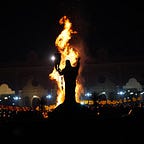A Worrisome Threat At The Zanzalima IDP Camp in Bahir Dar
I am writing this for those of you who are following the situation with Internally displaced peoples in Ethiopia’s Amhara region but this may potentially be the case throughout the country in IDP camps throughout Ethiopia. I am speaking on my experiences in just one camp, the Zanzalima Market Center in Bahir Dar which has been turned into an IDP camp housing IDP’s from Sekota, Wag Him, Lalibela and Tsagibji and others in the Amhara Region.
Zanzalima is by far the best improvised IDP camp I have seen in all of my travels here documenting IDP’s in Ethiopia over the past 11 months but there are situations that are arising that are making things difficult for the IDP’s housed there and can be rectified with a concerted effort from the community, willing humanitarians and the appropiate government agencies.
I want to draw attention to what is one of the trials that IDP’s face after being forced to leave their homes under duress due to the TPLF invasion of the Amhara region that began in July of 2021. Besides having to flee their homes, towns and villages, in most cases with only the cloths on their back, walking up to two weeks on foot in some cases, IDP’s in Zanzalima are lacking consistent access to basic resources. Adequate water for consumption and hygiene, consistent food aid and supply, clothing and other resources that make life livable. On top of all of that most if not all victims are suffering from some form of PTSD (Post Traumatic Stress Disorder) due to the trauma of fleeing war and escaping in some cases massacre and violent death at the hands of the TPLF.
People here in the Zanzalima Market Center are facing all of these challenges in addition to issues with lack of consistent support and presence of key institutions. Local AID operations and the Ethiopian Orthodox Tewaheda Church are doing what they can and making some difference but the need is overwhelming.
As if that’s enough, the population at Zanzalima are contending with another issue that is the source of a growing health corncern which is that of the Nairobi Fly.
The Nairobi Fly is actually a beetle that when it bites or is crushed it releases a chemical called “Pederin” which causes acid like burns and skin irritation. “More severe cases could happen if the toxin is more widespread over the body and could cause fever, nerve pains, joint pains or vomiting. When pederin comes into contact with people’s eyes, because of hand rubbing, it can cause conjunctivitis — also known as Nairobi eye — and potentially temporary blindness” — Josh Jenkins Shaw, Systematic Entomologist, Chinese Academy of Sciences.
When I reached Zanzalima on October 1, 2021 I spent time interviewing multiple people about their experiences escaping the TPLF and documenting conditions at the camp. I came upon a one year old child from Tsagibji who was suffering terribly with skin lesions and open sores.
My team came back the next day and we took the child and her mother to a clinic for examination. The child had developed a secondary bacterial infection due to the issues around her wounds caused by bites from the Nairobi Fly. We got prescription medication for both Mom and child and returned to the camp. Upon return to the camp we then discovered that her big brother was suffering as well. We then asked to do a survey with administrators and occupants from two blocks of housing at the camps. We discovered cases of skin burns and severe irritation due to Nairobi fly bites and pederin exposure throughout those two blocks. With four housing blocks affected we must assume the entire complex (roughly 12 blocks) is affected. Looking at the fact that I was able to pay for treatment of 3 affected individuals for the equivalent of $20, one can imagine what it may take to treat a camp of 5000, with 200 individuals on average arriving daily. And this is just one camp, out of dozens in the Amhara region. This camp housing one of the smaller populations of the over 300,000 displaced in this region alone. I haven’t even scratched the surface at Dessie/Wollo yet whose population of IDP’s when combined with those of the Gonder region are well over 1 million according to the latest figures.
The needs of the IDP’s in this camp alone are tremendous and diverse and will take cooperation among multiple entities to rectify. Let the mobilization begin in the name of humanity to better the conditions of those IDP’s at Zanzalima and all those IDP’s affected by acts of terror and war. I am currently working on resources through which to be active and support these efforts.
